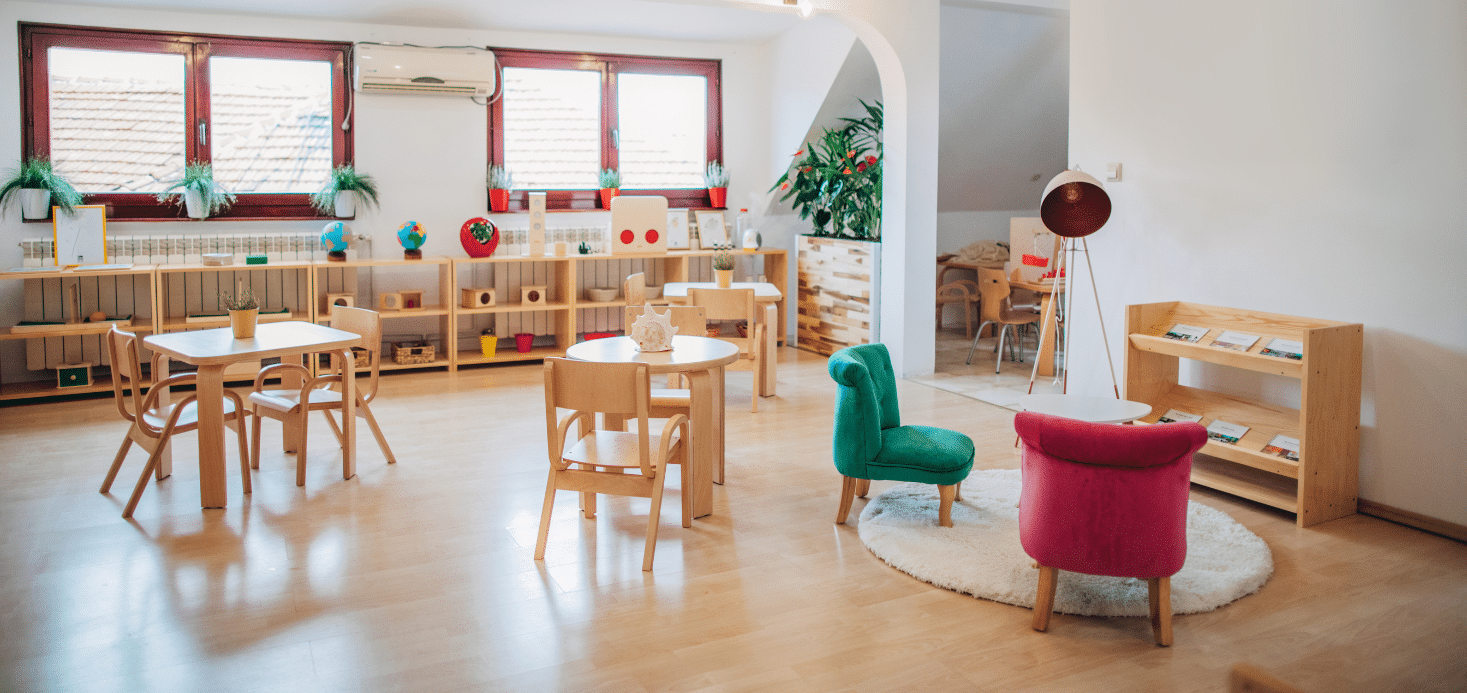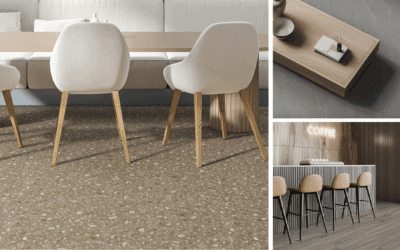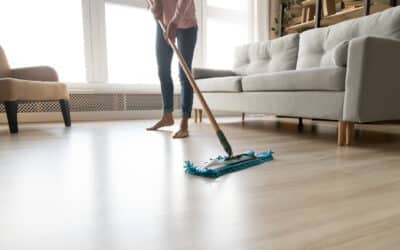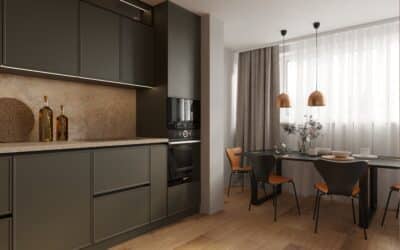The change in classroom environments over the past few years has been nothing short of remarkable, especially since the COVID-19 pandemic.
During the chaos of online school, if there’s one lesson learned by all, it’s that school classroom environments matter.
The pandemic caused educators to rethink what makes an effective learning space, resulting in a huge shift in classroom design.
Overall, we’re moving from colorful and vibrant designs to more natural and calming environments.
Current trends see educators trading excessive color for soothing, natural tones, and more modern school classrooms, which are worlds apart from the classrooms of the past.
And now, there’s another area under scrutiny: school flooring.
In this article, we explore the top options for school classroom flooring and see how it balances the needs of students and teachers.
Classroom Floors Built for Chaos, Creativity, and Care

We know that school classroom flooring has to withstand its fair dose of wear and tear.
The classroom is the place where children solve mind-bending math problems, craft the world’s wobbliest (and messiest) clay pots, create a mini volcano in science, and secretly swap snacks with their besties under the desk, right?
That’s why classroom flooring needs to handle it all – footsteps, moving chairs, and even the occasional explosion of glitter.
But durability isn’t the only concern. Safety is crucial, and when it comes to choosing the right flooring, health considerations play a significant role in making the best choice.
So let’s explore the pros and cons of different types of classroom flooring, and see how they meet the needs of students, teachers, and meet essential safety considerations.
Carpet
Commercial carpet is a popular choice for schools because it comes in vibrant colors and patterns.
Carpet also provides noise reduction and is comfortable under foot.
Here are the pros and cons of carpet vinyl flooring in schools.
Pros
- Carpets come in both modular and broadloom formats at affordable prices and with good durability.
- The option of modular tiles makes it easy to separate different areas in the classroom with variations in color, and if you need to replace a section of flooring, it’s easy and inexpensive.
- Carpets are softer and quieter than hard surfaces, reducing injury when children fall and reducing the risk of objects breaking.
Cons
- Studies have linked the use of carpets to worsened allergies and asthma. However, recent studies suggest that properly maintained carpets may trap allergens better than hard flooring, preventing them from circulating in the air.
- Aside from daily vacuuming, carpets also need a periodic deep clean to reduce allergens and bacteria.
- Carpets often require extra treatments to make them more resistant to stains.
Vinyl
Vinyl flooring in schools, including classrooms, is a prevalent floor type that is the easiest type to maintain.
It’s a highly resilient yet comfortable surface to walk on. And commercial vinyl is more durable than its residential counterpart.
Read the pros and cons of vinyl flooring in schools below.
Pros
- LVT is a synthetic flooring option available in vinyl sheets, tiles, and luxury vinyl planks.
- Very easy to maintain with sweeping and mopping.
- LVT is cost-effective and durable, so it’s a great choice for handling the heavy traffic in schools.
Cons
- Vinyl flooring has recently received harsh criticism from the possibility that it can cause harm to people and the environment. Read “Are America’s Floors Going Away?” for an overview of the potential health and environmental concerns.
- Researchers found that vinyl flooring in bedroom of children aged 1-3 was associated with the development of asthma.
Rubber
Rubber flooring is a popular choice in educational settings due to its durability and safety features, but it’s not without its problems.
While it offers numerous advantages that can enhance the school environment, concerns about chemical emissions raise questions about its long-term impact on health and well-being.
Pros
- Rubber flooring is durable and can handle lots of activity.
- It’s slip-resistant, making it safe for kids.
- The soft, cushioned surface helps absorb noise, creating a quieter learning environment.
- Although it may cost more upfront, its durability makes it a smart investment for schools.
- Like vinyl and modular carpet, rubber flooring is also easy to care for, requiring only regular sweeping and mopping to maintain.
Cons
- Rubber flooring has been a regular topic of debate regarding its use in the classroom due to concerns about chemical emissions, particularly from recycled rubber.
- Some types of recycled rubber can release heavy metals, which can pose risks to respiratory health and other long-term health issues.
- Rubber has a distinct smell that takes time to dissipate.
Hardwood
Among the many choices available, solid hardwood flooring stands out as a popular option due to its natural aesthetic and long-term value.
Natural materials are the essence of biophilic design, which offers superior aesthetics and connects people to nature.
Hardwood is a timeless material that helps promote learning.
Pros
- Solid hardwood flooring is a durable surface that can withstand high foot traffic, making it a good and long-lasting choice for classrooms.
- There are very affordable options of hardwood flooring on the market.
- Hardwood is easy to clean and maintain, so it’s a hygienic and practical option for classrooms.
- Unlike synthetic flooring options, hardwood is a biophilic material that supports indoor air quality, which is crucial for children’s health and concentration.
Cons
- Some hardwood flooring is more susceptible to scratches and dents, especially in high-traffic areas, which can affect the appearance over time.
- Hardwood floors can warp or expand when exposed to moisture, so spills must be cleaned up quickly to avoid damage.
- Hardwood is more expensive, so it’s use in schools is more strategic, such as in particular classrooms, gyms, and offices.
Conclusion
We’ve looked at the most popular choices for school classroom flooring today. Each flooring option comes with advantages and disadvantages.
From the allergens found in carpets to the possibility of off-gassing chemicals in vinyl and rubber, when it comes to selecting school classroom flooring, the responsibility we bear is enormous.
While not all claims are conclusively proven, the possibility of exposure to harmful substances should prompt us to prioritize safety without compromise.
Schools must strive to choose flooring that is 100% safe, ensuring a healthy environment for students to learn and grow. We need to explore our options for a toxic-free future and look for alternatives and guidance for making better and safer decisions.
What really matters is that classrooms are spaces where children spend hours each day – learning, sitting, playing, or even eating on the floor.
Want to discuss flooring options for your school and classroom?
Contact us today for more information about the commercial flooring solutions we offer.
We’ll be there for you and your school to ensure that the environment you provide future generations is not only functional – but healthy too.



